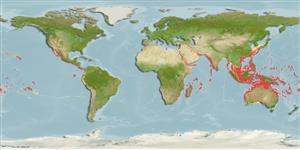Common names from other countries
Classification / Names / Names
ชื่อสามัญ | ชื่อพ้อง | Catalog of Fishes (gen., sp.) | ITIS | CoL | WoRMS
Environment: milieu / climate zone / depth range / distribution range
นิเวศวิทยา
; ระดับความลึก 5 - 112 m (Ref. 3174). Tropical
Indo-Pacific: From the Red Sea and East Africa to Hawaii and French Polynesia.
Length at first maturity / ขนาด / น้ำหนัก / Age
Maturity: Lm ? range ? - ? cm Max length : 20.0 cm CW เพศผู้/กระเทย; (Ref. 3174); 17.2 cm CW (female)
Carapace rounded, as wide as or slightly wider than long; surfaces convex, with dense pubiscence; 5 anterolateral teeth, median ones largest. No spine present on outer margin of dactylus of last walking leg. Color: light brown overall with pink fingers.
Largest dromiid known (Refs. 343, 122680). Epizoic. Subtidal on hard bottom (Ref. 106854). Occurs at depths of 5 to 50 m. Prefers moderately shallow waters with rocky-muddy substrates, sometimes near reefs. Omnivorous, feeds on sea stars. Carries sponges and colonial tunicates on its back for camouflage (Ref. 343). Can occasionally be found sheltering under old bivalve shells (Ref. 125338). Predator (Ref. 128960).
Life cycle and mating behavior
วัยเจริญพันธุ์ | การสืบพันธุ์ | การวางไข่ | เซลสืบพันธ์ของเพศเมีย(ไข่) | ความดกของไข่ | ตัวอ่อน
Members of the order Decapoda are mostly gonochoric. Mating behavior: Precopulatory courtship ritual is common (through olfactory and tactile cues); usually indirect sperm transfer.
Ng, P.K.L. 1998. (Ref. 343)
IUCN Red List Status (Ref. 130435)
CITES status (Ref. 108899)
Not Evaluated
Not Evaluated
Human uses
การประมง: มีการค้าเพียงเล็กน้อย
| FishSource |
เครื่องมือ
แหล่งที่มาจากอินเตอร์เน็ต
Estimates based on models
Preferred temperature
(Ref.
115969): 22 - 29, mean 27.8 (based on 1662 cells).
Vulnerability
Low vulnerability (10 of 100).
Price category
Unknown.
